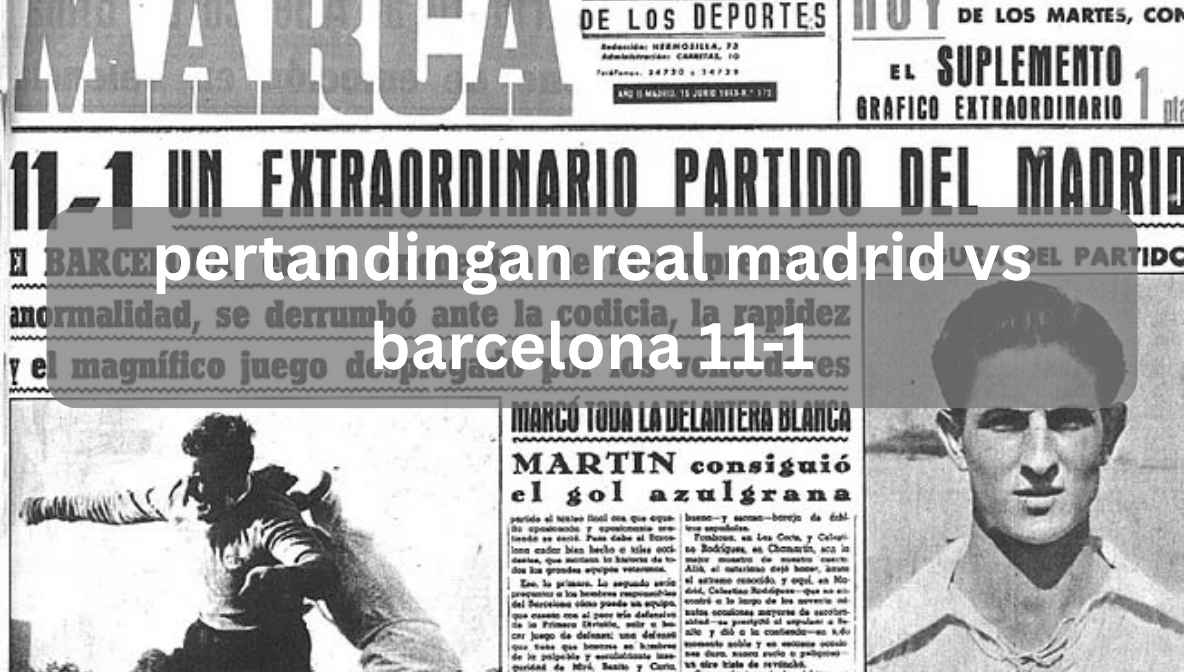The pertandingan Real Madrid vs Barcelona 11-1 is not just a football score — it’s a story of politics, rivalry, and sportsmanship. On June 13, 1943, in the second leg of the Copa del Generalísimo semifinal, Real Madrid defeated Barcelona with a stunning 11-1 score. The first leg had ended 3-0 in favor of Barcelona, but what happened in the return leg at Chamartín Stadium left a mark on Spanish football history.
This match is remembered not just for the goals but for the tension and alleged political influence during Franco’s dictatorship. Reports of threats and unfair pressure on Barcelona players added a dark shadow to the result.
The pertandingan Real Madrid vs Barcelona 11-1 remains controversial and symbolizes the intersection of sports and state power.
Key Points:
- Real Madrid scored 11 goals in the second leg.
- Barcelona had won the first leg 3-0.
- Political pressure reportedly affected the outcome.
What Happened During the Match?
Held at Real Madrid’s Chamartín Stadium, the second leg started under intense atmosphere. Barcelona entered the match with a 3-0 lead on aggregate. However, Real Madrid quickly took control. By halftime, the score was already 8-0. The match ended with a shocking 11-1 victory for Real Madrid.
Barcelona players appeared demoralized and distracted. The crowd of over 20,000 fans created an extremely hostile environment. Reports suggest that police and government officials intimidated Barcelona players before kickoff, warning them to “not try too hard.”
Some players later hinted at the psychological pressure they faced, while others remained silent. This gave rise to the belief that the match result wasn’t solely determined by football tactics.
Note: The 11-1 scoreline is still the biggest in El Clasico history.
Was There Political Influence?
Many football historians believe that the pertandingan Real Madrid vs Barcelona 11-1 was influenced by the political climate. In 1943, Spain was under General Franco’s dictatorship. Real Madrid was often viewed as the regime’s club, while Barcelona symbolized Catalan identity and resistance.
Prior to the match, Barcelona players reportedly received visits from authorities warning them of the consequences of a strong performance. The press also heavily favored Real Madrid and ignored the unusual circumstances of the match.
Here is a comparison of the situation:
| Factor | Barcelona | Real Madrid |
|---|---|---|
| First Leg Result | Won 3-0 | Lost 0-3 |
| Second Leg Atmosphere | Hostile, threatening | Supportive and intense |
| Political Pressure | Reportedly received threats | Allegedly protected by the regime |
Note: Although no official proof exists, many believe political interference played a major role.
How Did This Game Shape the Rivalry?
The pertandingan Real Madrid vs Barcelona 11-1 ignited decades of rivalry. For Barcelona fans, it became a symbol of injustice. For Real Madrid supporters, it was an incredible comeback. This match fueled the emotional fire behind every future El Clasico.
In fact, the rivalry between these two clubs is no longer just about football. It represents cultural, regional, and political differences. Barcelona’s motto “Més que un club” (More than a club) reflects how deeply rooted these feelings are.
| Impact Area | Result |
|---|---|
| Football Rivalry | Intensified permanently |
| Club Identity | Barcelona became a symbol of resistance |
| International Attention | El Clásico became a global phenomenon |
What Changes Followed This Controversial Match?
In response to the backlash, the Spanish Football Federation introduced new rules. They aimed to reduce political interference in football. For example, future cup semifinals would not pair politically sensitive teams without neutral planning.
Barcelona restructured its management and focused on rebuilding. Over the decades, the club grew into one of the most successful and respected teams in the world. Real Madrid, on the other hand, continued to dominate both domestically and in Europe.
This match made both clubs aware of the importance of transparency, fair play, and the global image of Spanish football.
What Can Fans Learn From This Historic Game?
The pertandingan Real Madrid vs Barcelona 11-1 teaches us that football does not exist in a vacuum. External influences, whether political or social, can deeply affect the outcome of games. It reminds us of the importance of fair play and the need to protect the integrity of the sport.
As fans, understanding the context of past matches helps us appreciate today’s games even more. El Clásico has since become a showcase of skill, pride, and legacy — a rivalry shaped not only by goals but also by history.
Conclusion: More Than a Match
To this day, the pertandingan Real Madrid vs Barcelona 11-1 stands as a shocking example of how powerful football can be in society. The scoreline itself is only part of the story. Behind it lies a tale of politics, identity, and transformation.
Both clubs have come a long way since 1943, but this match remains a defining moment in El Clásico history. Whether viewed as a sporting miracle or a controversial injustice, it is a reminder of football’s enduring power to reflect the world around it.
FAQs
1. When did the pertandingan Real Madrid vs Barcelona 11-1 happen?
It took place on June 13, 1943, during the Copa del Generalísimo semifinal.
2. Why is this match controversial?
Because many believe political pressure influenced the outcome, making it more than just a football match.
3. Is this the biggest El Clásico scoreline ever?
Yes, the 11-1 result is the highest ever in an El Clásico match.
4. Was the match fair?
Reports of threats and pressure on Barcelona players suggest the match may not have been played fairly.
5. How did this match affect Spanish football?
It led to structural changes in tournament organization and deepened the Real Madrid vs Barcelona rivalry.

